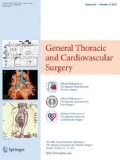Non-small cell lung cancer (NSCLC) is the most common cause of cancer-related death worldwide. However, if it is found at an early stage before it has spread, we can provide successful treatment for cure in these patients. The diagnosis of NSCLC is often delayed because symptoms often do not appear until the disease is at an advanced stage. Research has shown that using low-dose CT scans to screen people at higher risk of lung cancer can reduce lung cancer-specific death. When a small nodule is found, establishing a tissue diagnosis continues to be a challenge. Navigation bronchoscopy and other techniques have emerged over recent years to improve the diagnostic yield.
Surgical resection remains the first-line treatment for patients with early-stage NSCLC. In the era of minimally invasive surgery, intraoperative identification of the tumor can be difficult, particularly if the nodule is small. To overcome this challenge, various tumor localization techniques have been developed. The outcome of surgical treatment using minimally invasive techniques is outstanding.
Despite these advances, there are still many unsolved problems in the diagnosis and treatment for early-stage NSCLC. This special issue provides updated medical and surgical information reported by experts from all over the world. The state-of-the-art knowledge contained within this issue will help to find solutions for unsolved problems.

Author information
Authors and Affiliations
Corresponding author
Additional information
Publisher's Note
Springer Nature remains neutral with regard to jurisdictional claims in published maps and institutional affiliations.
Rights and permissions
About this article
Cite this article
Jones, D.R., Date, H. Preface. Gen Thorac Cardiovasc Surg 68, 659 (2020). https://doi.org/10.1007/s11748-020-01413-3
Published:
Issue Date:
DOI: https://doi.org/10.1007/s11748-020-01413-3

